Alaska Fish & Wildlife News
July 2024
Going High Tech in an Old School Plane
to Count Wood Bison
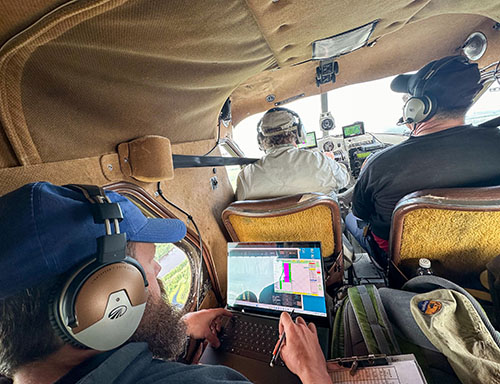
How many animals are there? This seemingly simple question has plagued wildlife biologists since the dawn of the profession. Heck, my 40-year career in wildlife biology was mostly focused on field and statistical methods for counting animals and in turn learning about how many survive, immigrate, emigrate, and are born. Ironically, the solution to the challenge of enumerating animals may come from technology used in my second career…photography.
Our attempt to count the number of wood bison in the Innoko region on 20 June used about 150 years of combined experience in wildlife biology, cutting edge photographic technology, and three planes, including a 1951 DeHavilland Beaver piloted by Bruce Dale, the former director of the Wildlife Conservation Division for ADF&G who started in the wildlife profession the same year I did, 1984. Nate Pamperin, wildlife biologist for ADF&G, manned the three, 150-megapixel cameras mounted in the belly of the plane. These state-of-the-art cameras are guided by computer software that simultaneously provides information like plane altitude, speed, and the flight path to Pamperin and Dale so photos are taken at an exact place and time. Board of Game member Al Barette and I were the other passengers in the Beaver.
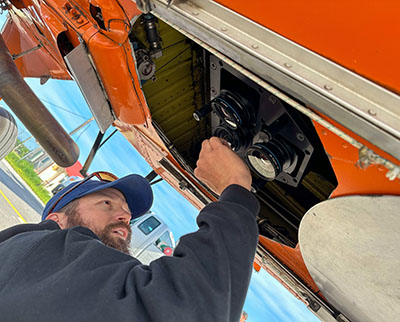
Interestingly, one of the main reasons that the modern cameras are mounted in the 1951 Beaver is because this plane has a factory installed belly port for reconnaissance. This port is lacking in more modern planes, and it may take as much as 300 hours of labor to install a port and reroute various control cables.
Mark Keech with Swift Fork Air piloted a Super Cub that left Fairbanks at 0500 to track radio-tagged bison and provided initial intel on their location. Similarly, Tom Seaton, lead biologist for the wood bison project, flew a Bellanca Scout from Fairbanks to locate bison and to orchestrate the dance among the three planes.
The planes were headed about 400 miles southwest of Fairbanks to an area near the confluence of the Innoko and Yukon Rivers. Seaton has been carefully monitoring the population of wood bison that were restored to the region in 2015, and he’s made many trips to learn how bison fared over the winter, to document how many calves were born in the spring, and track how their numbers fluctuate as they establish themselves.
After receiving coordinates from Keech and Seaton about the location of the tagged bison via radios and satellite texting, Pamperin plotted a flight path and shared it with Dale using the computer that was communicating with the cameras and navigation screens. Dale lined up the Beaver and passed over the group of about 60 bison at 1,200-feet while Pamperin snapped photos using the three cameras mounted in a gimbal system that assures the cameras are perfectly level. The images are then saved for processing later. The large group of bison contained all but one of the radio collars. We also captured photos of three other smaller groups of bison we located in the region.
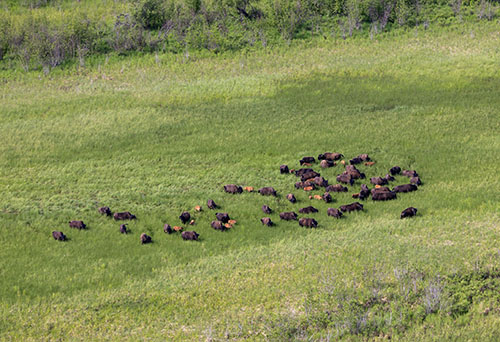
Back in the office Pamperin will count the number of bison captured in each photo. This is relatively easy for smaller groups of animals like we observed during our survey, but this gets much more complex for larger herds of thousands of animals, which you might see when surveying animals like caribou. Pamperin is working with Microsoft to develop algorithms to automate the counting process for these larger groups.
So, if we add together all the wood bison we captured in the images would we have a census or a complete count of all bison in the Innoko region? Maybe. Not only do you have to accurately count all the bison captured in each image to have a census, but you also need to capture all the bison in the region of interest on an image. On any day, bison may be in areas, like lying down in the trees, not visible to us even from the air. In fact, we spotted a lone bison on one pass and when we came back around on three subsequent passes to get a better look, we could not find the bison who had walked into some trees.
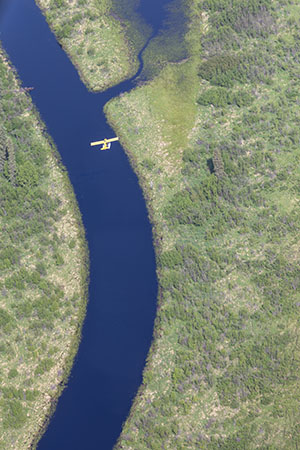
Based on his experience with this herd of wood bison, Seaton was not convinced we captured all the wood bison in our photos on that day so this count will be regarded as a minimum count, and the high resolution photos will be used to estimate the sex and age-class composition of the herd. In all the photos, a total of 74 bison were seen, including a banner calf count of 21, one of the highest percentage of calves for this herd.
Based on low mortality experienced by the radiocollared members of the herd last winter, the population has likely increased more than just two bison from the total count of 72 in 2023. Seaton suspects that some bison were not seen, and he will continue his efforts to get a more complete count during the rut gatherings of late July and August and when the first snow comes.
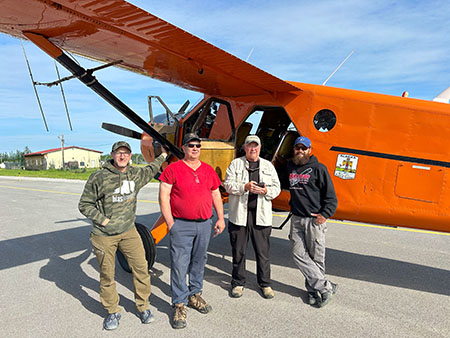
One of the main reasons I pursued a career in wildlife biology was the excitement of discovery and learning about the mysteries of wildlife. We have come a long way since I entered the profession 40 years ago when biologists were tabulating what they saw using a hand clicker from the air and ground. Some of those biologists may have flown in the Beaver now outfitted with state-of-art cameras that we used for this bison survey. However, we still have work to do before we remove all the mystery and personally, I’m okay with that.
Dr. Mark Lindberg was awarded the last degree in Wildlife Management at the University of Alaska Fairbanks in 1997 and he spent 29 years of his career studying wildlife biology in Alaska. His expertise is in population ecology with an emphasis on estimation of population characteristics such as abundance and survival probability. His work on Alaska wildlife includes studies of numerous waterfowl populations, Rock and Willow Ptarmigan population dynamics in Interior Alaska, and analysis of the data on survival of McGrath moose. He looks forward to continuing to combine his passion for photography with his knowledge of wildlife population ecology.
Subscribe to be notified about new issues
Receive a monthly notice about new issues and articles.
